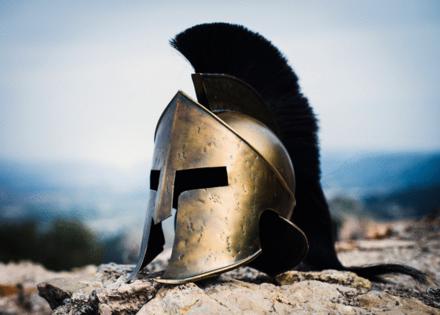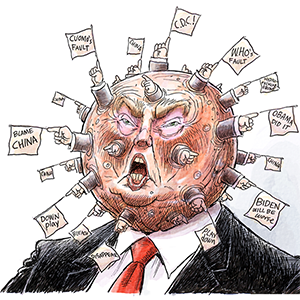Commentary: When democracy's symbols get hijacked -- How the far right co-opted classical imagery
Published in Op Eds
For generations, Americans have surrounded themselves with the symbols of ancient Greece and Rome: marble columns, laurel wreaths, Roman eagles, and the fasces. These icons, carved into our government buildings and featured on our currency, were intended to embody democracy, civic virtue, and republican ideals.
But in recent years, far-right movements in the U.S. and abroad have hijacked these classical images, repackaging them into symbols of exclusion, militarism, and authoritarian nostalgia.
As a student of both Classical Civilizations and Public Policy, I’ve seen this trend firsthand. Online spaces and political rallies now bristle with distorted classical references: Spartan helmets on protest gear, Roman eagles on alt-right banners, and phrases like molon labe (“come and take them”) lifted from ancient Greek battles but weaponized for modern culture wars.
This isn’t accidental. Extremist groups deliberately lean on classical symbolism to project legitimacy and historical grandeur. Their goal is to link their movement with notions of strength, order, and Western identity – often coded with racial and cultural exclusion.
The far right’s fascination with the ancient world has deep roots. In the 1920s and ’30s, Benito Mussolini drew heavily on Roman imagery to build Italian Fascism, adopting the fasces (a bundle of rods and an axe once carried by Roman magistrates) as the regime’s primary emblem. Nazi Germany followed suit, celebrating classical sculpture and architecture as models of supposed Aryan purity, while denouncing modern art as “degenerate.”
Today’s extremists borrow these same visual cues. The January 6 Capitol riot showcased Spartan and Roman symbols among the flags and homemade shields. In Charlottesville, at the 2017 Unite the Right rally, white nationalists marched with fasces emblems and the Roman acronym SPQR, the historic motto of the Roman Republic. White nationalist groups like Identity Evropa and Vanguard America continue to embed Roman eagles and Greek statuary into their propaganda materials.
The strategy is clear: these symbols evoke a sense of timeless authority and noble struggle. They suggest a connection to ancient civilizations that are popularly, but often simplistically, viewed as the cradle of democracy and Western greatness.
And that brings us to an uncomfortable truth: this hijacking is made easier by the way mainstream American culture has mythologized the classical world for decades.
For many Americans, Greece and Rome have long been portrayed in a sanitized narrative: Athens as the pure birthplace of democracy, and Rome as a republic of virtuous citizens. Our civic buildings mimic the Parthenon and Pantheon. Our textbooks focus on Athenian voting rights and Roman legal codes, often skipping over the less flattering realities: slavery, imperialism, patriarchy, and political collapse.
By flattening classical history into a story of unbroken democratic virtue, we’ve created a blind spot. Extremist groups exploit this by framing themselves as heirs to an imagined tradition of Western strength and purity.
Take the Spartan obsession, for example. In reality, Sparta was a militarized society that depended on the mass enslavement of the helot population and engaged in routine violence to maintain social order. However, modern far-right groups latch onto a Hollywood-inspired version of Sparta: all heroism, all warrior ethos, with no historical context.
The same goes for Roman imagery. The fasces, which in the U.S. have long symbolized unity and civic authority, are now appearing on hate group banners to signal authoritarian power. Even the Latin motto SPQR, originally an emblem of citizen governance, has been stripped of context and repurposed for modern nationalist signaling.
So, how do we respond?
First, educators have a critical role. As a classics student, I’ve learned that understanding Greece and Rome means wrestling with contradictions: innovation and oppression, civic ideals and systemic injustice. Middle and high school teachers, as well as university professors, should present the classical world in its full complexity—not as a golden age to be uncritically admired. Students should leave a unit on Athens knowing not only about democracy, but also about who was excluded from it.
Second, policymakers and civic leaders must be mindful of how they use classical symbols today. While classical architecture and symbolism remain fixtures in public life, their deployment must be accompanied by an awareness of how extremists are attempting to reframe their meaning. Civic leaders should refrain from using these images in ways that inadvertently echo extremist aesthetics, particularly in campaign materials or public art.
Third, online platforms and moderators play a crucial role. Just as we flag hate symbols and dog whistles in other contexts, there should be an awareness of how classical imagery is being used in far-right propaganda. This doesn’t mean banning every Roman eagle, but it does mean being alert when such symbols appear alongside calls to violence or exclusion.
Finally, the general public needs to approach classical imagery with more historical literacy. The solution isn’t to erase Greece and Rome from our civic identity, but to study them with clear eyes. When we understand their full history, including their flaws, failures, and complexities, we rob extremists of the ability to manipulate these symbols unchallenged.
The classical world was never monolithic, and neither is our democracy. Both are complicated, diverse, and constantly evolving. If we want democratic symbols to remain tools for inclusion rather than division, we need to reclaim them from those who would distort the past to undermine the present.
____
Bennett Gillespie is a student at Duke University and a council member of the Duke Program in American Grand Strategy. He is also an intern with the Fulcrum.
_____
©2025 The Fulcrum. Visit at thefulcrum.us. Distributed by Tribune Content Agency, LLC.

























































Comments